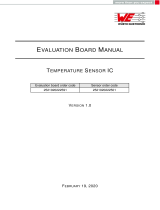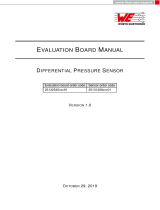
UM10780 All information provided in this document is subject to legal disclaimers. © NXP Semiconductors N.V. 2014. All rights reserved.
User manual Rev. 1 — 7 May 2014 19 of 27
NXP Semiconductors
UM10780
TEA1721ADB1102 GreenChip 5 W QBIC demo board
9. Circuit description
The GreenChip SP TEA1721AT demo board consists of a single-phase full-wave rectifier
circuit, a filtering section, a switching section, an output section and a feedback section.
Figure 14
shows the circuit diagram. Table 4 shows the component list.
9.1 Rectification section
The bridge diodes D1a to D1d form the single-phase full-wave rectifier. Capacitors C1 and
C2 are reservoir capacitors for the rectified input voltage. Resistor RF1 limits inrush
current and acts as a fuse. Terminals J1 and J2 connect the input to the electricity utility
network. Swapping these two wires has no effect on the operation of the converter.
9.2 Filtering section
Inductor L1, with capacitors C1 and C2, form a filter to attenuate conducted differential
mode EMI noise.
9.3 GreenChip SP section
The TEA1721AT device (IC1) contains the power MOS switch, oscillator, CV/CC, start-up
control and protection functions all in one IC. Its integrated 700 V MOSFET allows
sufficient voltage margins in universal input AC applications, including line surges. The
auxiliary windings on transformer T1 generate the supply voltage and primary sensing
information for the TEA1721AT. Diode D3 and capacitor C5 half-wave rectify the voltage.
Capacitor C5 is charged via the current limiter resistor R8. The voltage on capacitor C5 is
the supply voltage for the VCC pin.
The RCD-R clamp consisting of R4, C4, D2 and R5 limits drain voltage spikes caused by
leakage inductance of the transformer.
9.4 Output section
Diode D4 is a Schottky barrier type diode and capacitors C6/C8 rectify the voltage from
secondary winding of transformer T1. Using a Schottky barrier type diode results in a high
efficiency of the demo board. Capacitors C6, C8, and C10 must have sufficient low ESR
characteristics to meet the output voltage ripple requirement without adding an LC post
filter. Resistor R9 and capacitor C9 dampen high frequency ringing and reduce the voltage
stress on diode D4. Resistor R10 provides a minimum load to maintain output control in
no-load condition.
9.5 Feedback section
The TEA1721AT controls the output by current and frequency control for CV and CC
regulation. The auxiliary feedback winding on Transformer T1 senses the output voltage.
The FB pin senses the reflected output voltage using feedback resistors Rfb1 and Rfb2.

























